Coq au vin is a hearty French stew of chicken braised in red wine with vegetables and herbs, and finished with sautéed mushrooms and pearl onions. This richly flavored stew is perfect for cold days when you just want to curl up with a plate of something warm and delicious.
Full Instructional Video
With a flavor profile similar to Beef Bourguignon, Coq au Vin has become one of our family’s favorite rustic French-style stews.
Popularized by one of my favorite chefs, Julia Child, this stew is known for its depth of flavor, fall-apart-tender chicken, and its simplicity.
Traditionally, this stew is made with a rooster that’s braised in Burgundy wine, however, my coq au vin recipe makes it more accessible by using chicken legs and thighs, and a cheaper red wine.
I also add a small amount of dark chocolate at the end to intensify the rich flavor.
Coq au Vin is wonderful served with crusty bread, mashed potatoes, or creamy polenta, and a glass of Pinot Noir or Burgundy to complement the flavors of the dish.
Recipe Ingredients
All ingredients for this recipe are shown in the pic below and special notes are made in this bulleted list to assist you.
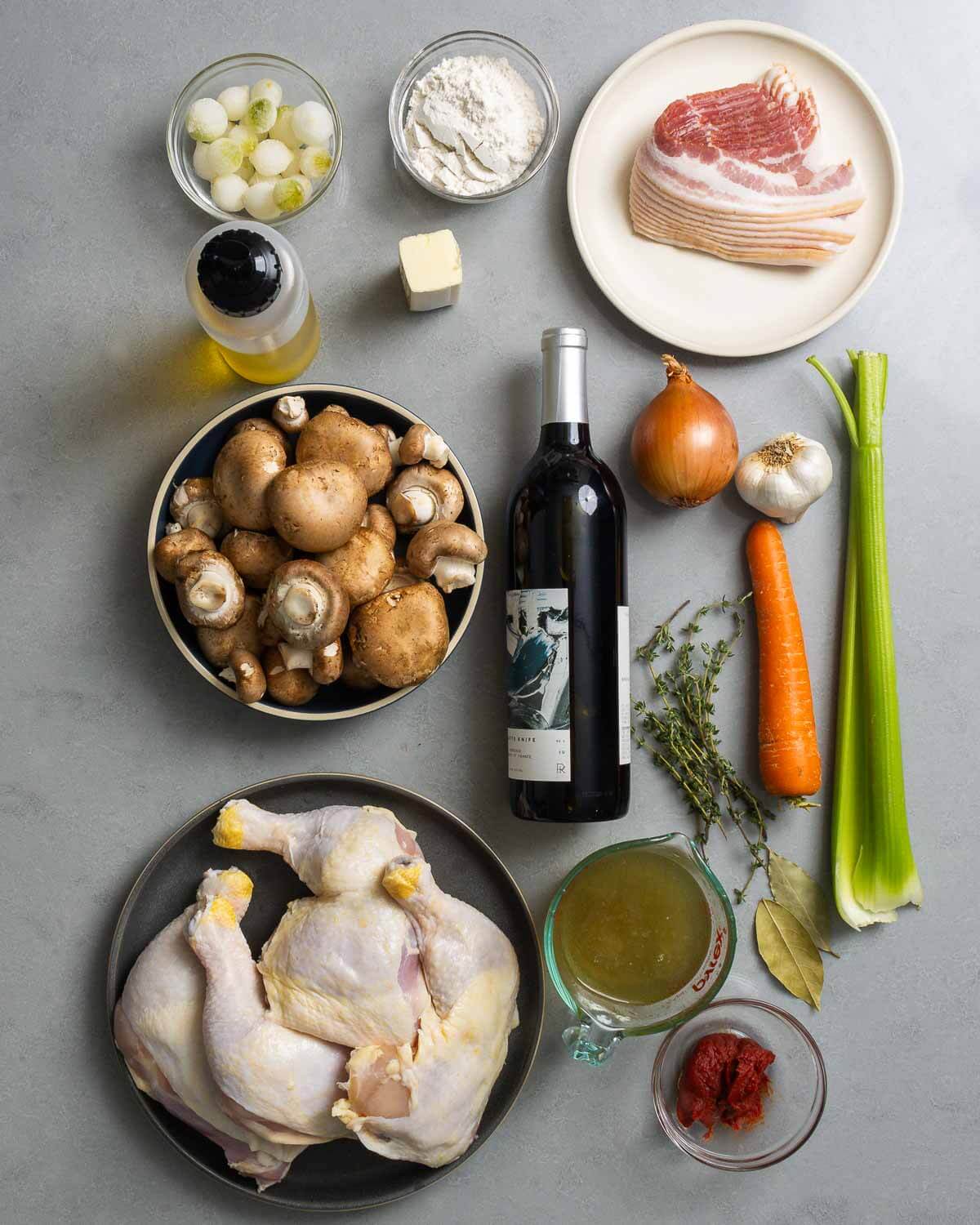
This post may contain affiliate links. Our disclosure policy.
- Chicken. I used chicken quarters (thighs and legs) for this recipe. You can use all legs or all thighs if you prefer. I do recommend using dark meat instead of white meat (breasts) which would entail a different cooking process.
- Wine. Traditional coq au vin would usually include a Burgundy wine (made from Pinot Noir grapes grown in the Burgundy region of France), however, you can definitely use another type of Pinot Noir, or other dry reds. I recommend using a red of the same quality you’d drink since it is a large component of this dish.
- Bacon. This is the fat that’s used to start the dish.
- Onions, carrots, and celery. These aromatics add flavor and some sweetness.
- Herbs. I use fresh thyme sprigs tied together for easy retrieval post-braising, and dried bay leaves for additional flavor.
- Chicken stock. Whenever possible, use homemade chicken stock, otherwise opt for a stock made from chicken base such as Better Than Bullion brand.
- Mushrooms and pearl onions. Cremini mushrooms and pearl onions add great texture and flavor and are cooked separately in butter and herbs at the end.
- Dark chocolate (not pictured above). While optional, this adds additional depth and richness to the coq au vin.
See the recipe card for full information on ingredients and quantities.
How to make it
Each number corresponds to the numbered written steps below.
- Trim 3 1/2 – 4 pounds of chicken legs and thighs of any excess fat and place in a large bowl. Pour an entire bottle of Burgundy or other dry red wine and marinate the chicken for at least 2 hours but up to overnight (Photo #1).
- While the chicken marinates, dice 1 medium white onion, 1 large carrot, and 2 celery ribs. Mince 5 cloves of garlic and tie 8 sprigs of thyme together and set aside. When the chicken is done marinating, remove it from the bowl and place on a work surface. Do not discard the wine as you’ll need it for later in the recipe. Pat the chicken very dry with paper towels and season with salt and pepper on all sides (Photo #2).
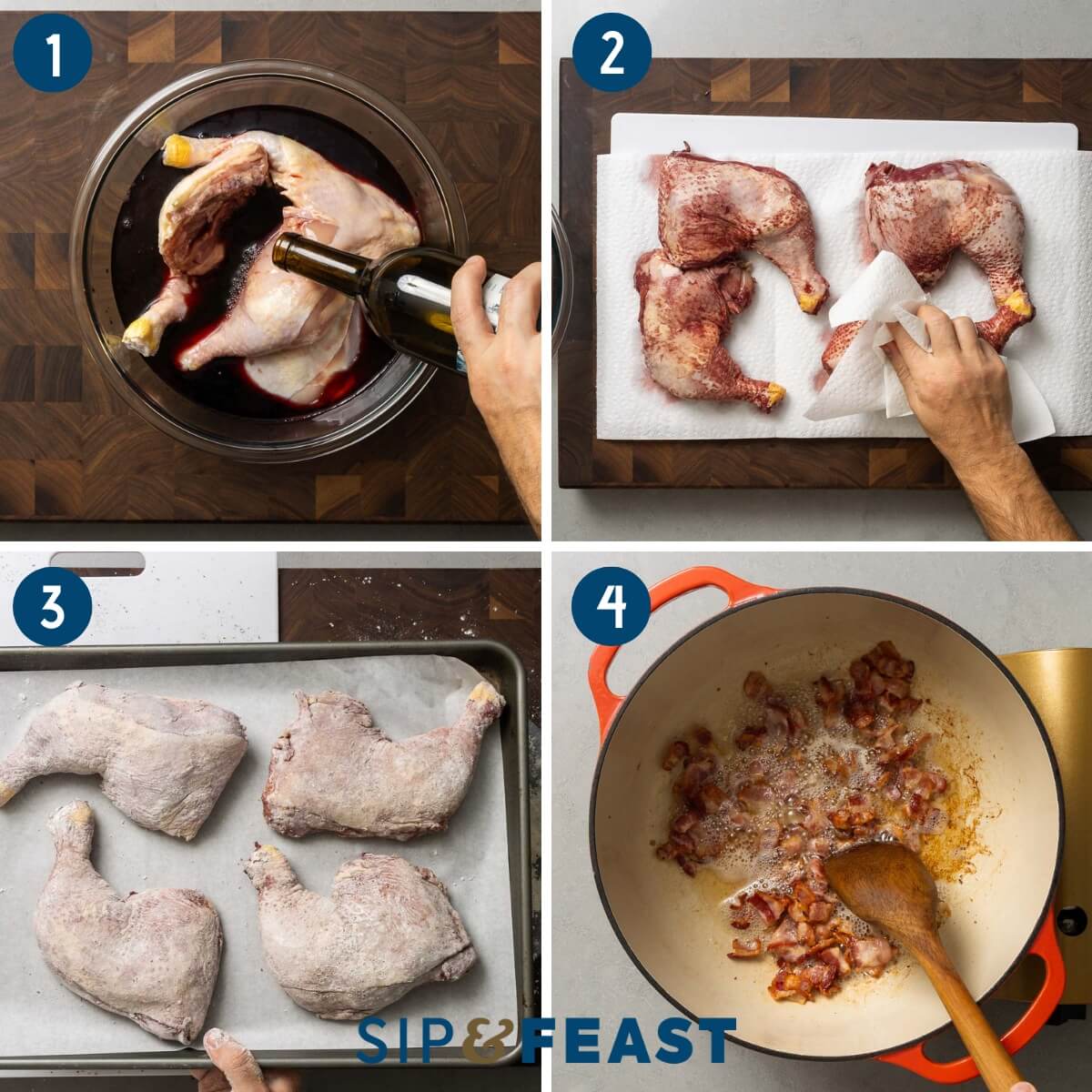
- Preheat the oven to 350f and set the rack to the middle level allowing enough room to accommodate a large Dutch oven and its lid. Dredge the chicken in flour and shake gently to remove the excess and set aside on a parchment paper lined baking sheet (Photo #3).
- Heat a large Dutch oven to medium heat, slice 4 ounces of thick cut bacon into 1″ pieces, and cook in the pot until most of its fat has rendered, about 7-10 minutes. Remove the bacon with a slotted spoon and place on a paper-towel-lined plate to drain (Photo #4).
- Add the chicken to the pot and sear the pieces in the bacon fat until well browned on all sides, then move the chicken to another plate and set aside. Work in batches to avoid overcrowding (Photo #5).
- Remove any excess bacon and chicken fat from the pot leaving about a 1/4 cup worth in the pot. Add the onions, carrots, and celery to the pot and cook for 10-12 minutes or until they begin to soften, then add the garlic and cook until fragrant (about 2 minutes) (Photo #6).
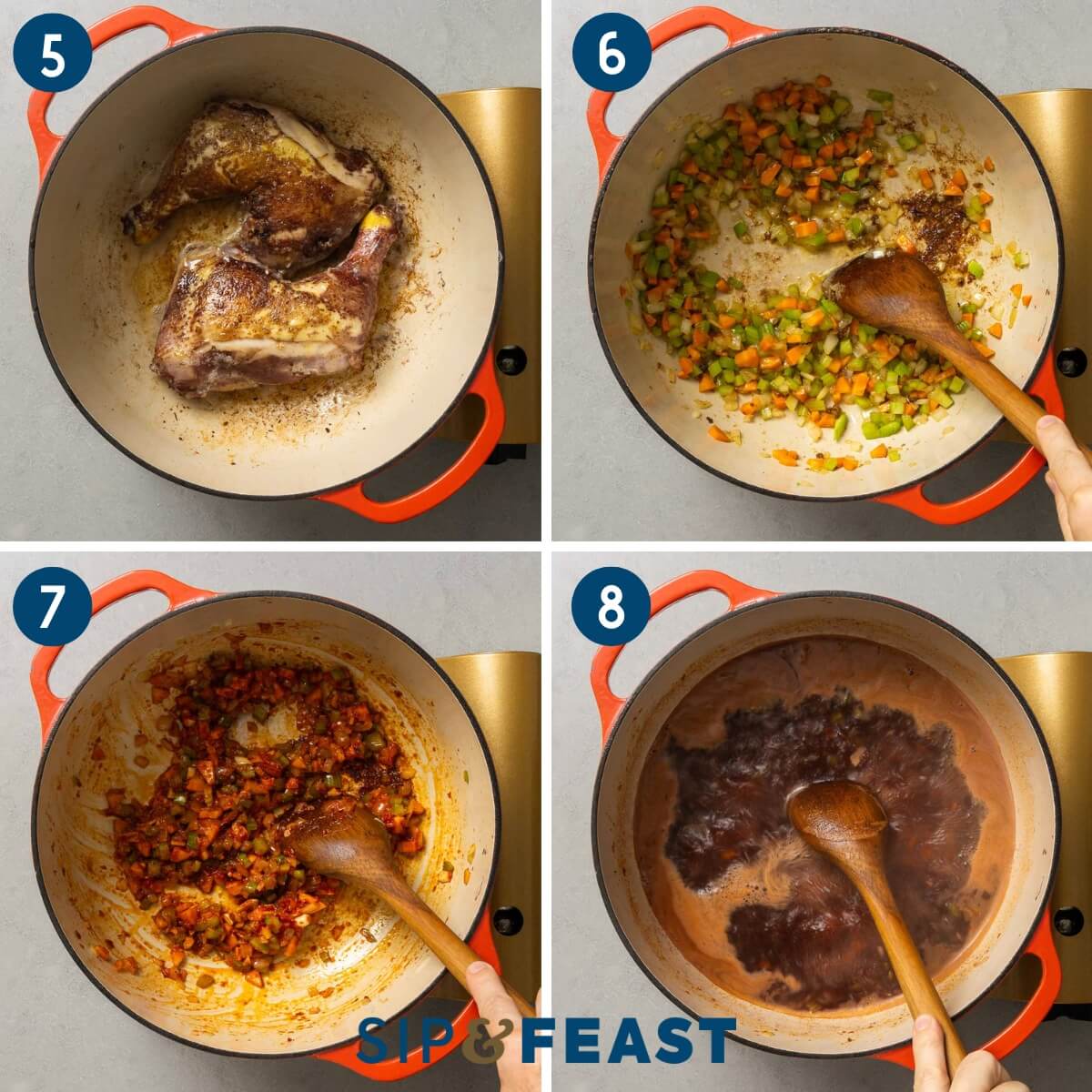
- Add 3 tablespoons of tomato paste and cook for 3-4 minutes and stir frequently to avoid burning. If there is any burning, add a splash of water to lower the temperature of the pot (Photo #7).
- Add the wine and 1 cup of chicken stock to the pot and bring to a boil. Use a flat wooden spoon to scrape the bottom of the pot to dislodge any brown bits (Photo #8).
- After 2 minutes of boiling turn off the heat and add the chicken, bacon, thyme, and 2 bay leaves to the pot. Cover the pot and place it in the oven to cook for 75-90 minutes or until the chicken is very tender (Photo #9).
- While the chicken braises, slice 1 pound of cremini mushrooms into quarters, mince 3 tablespoons of parsley, and remove 2 teaspoons worth of fresh thyme leaves from their stems. Heat a large pan to a touch higher than medium heat and add 2 tablespoons of olive oil and 16 pearl onions. Cook the onions until tender, about 3-5 minutes, then remove with a slotted spoon and place on a plate covered with foil to keep warm (Photo #10).
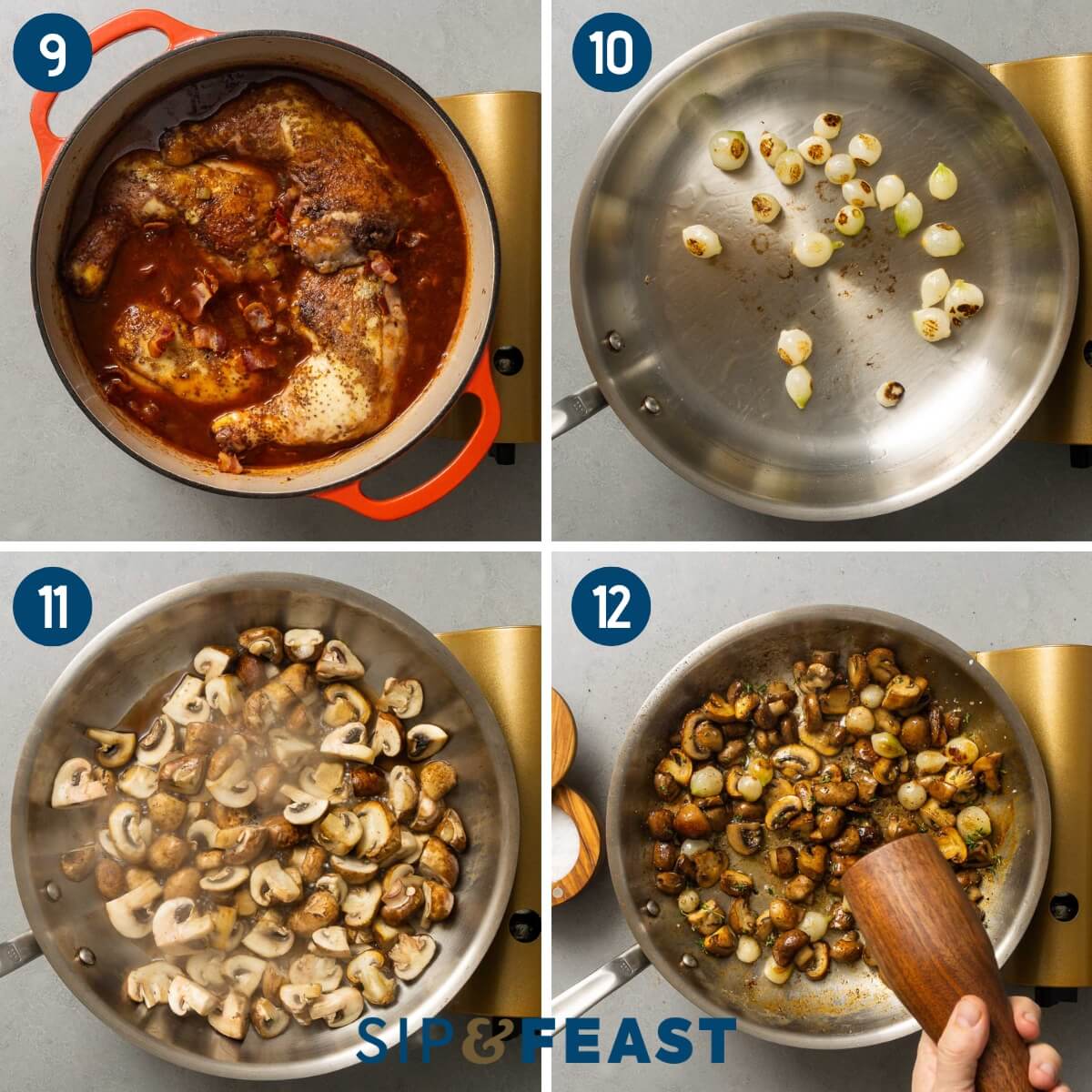
- Add the mushrooms to the same pan and cook until they release their water and begin to brown, about 5-8 minutes. Once brown, add 3 tablespoons of butter and cook for 2-3 minutes or until glistening (Photo #11).
- Return the pearl onions to the pan and toss or mix with the mushrooms to coat with the butter. Turn off the heat and season with salt and pepper to taste, and the thyme leaves (Photo #12).
- Once the chicken is tender, remove from the pot and place on a plate covered with foil to stay warm (Photo #13).
- Remove the thyme sprigs and bay leaves from the pot and discard. Skim any visible fat from the top of the sauce pot and move to a burner over medium-high heat. Reduce the sauce for about 10 minutes, stirring occasionally, or until thickened and reduced by half. The sauce should be thick enough to coat the back of a wooden spoon. Add a 1/2 ounce of dark chocolate (if using) and mix until very smooth (Photo #14).
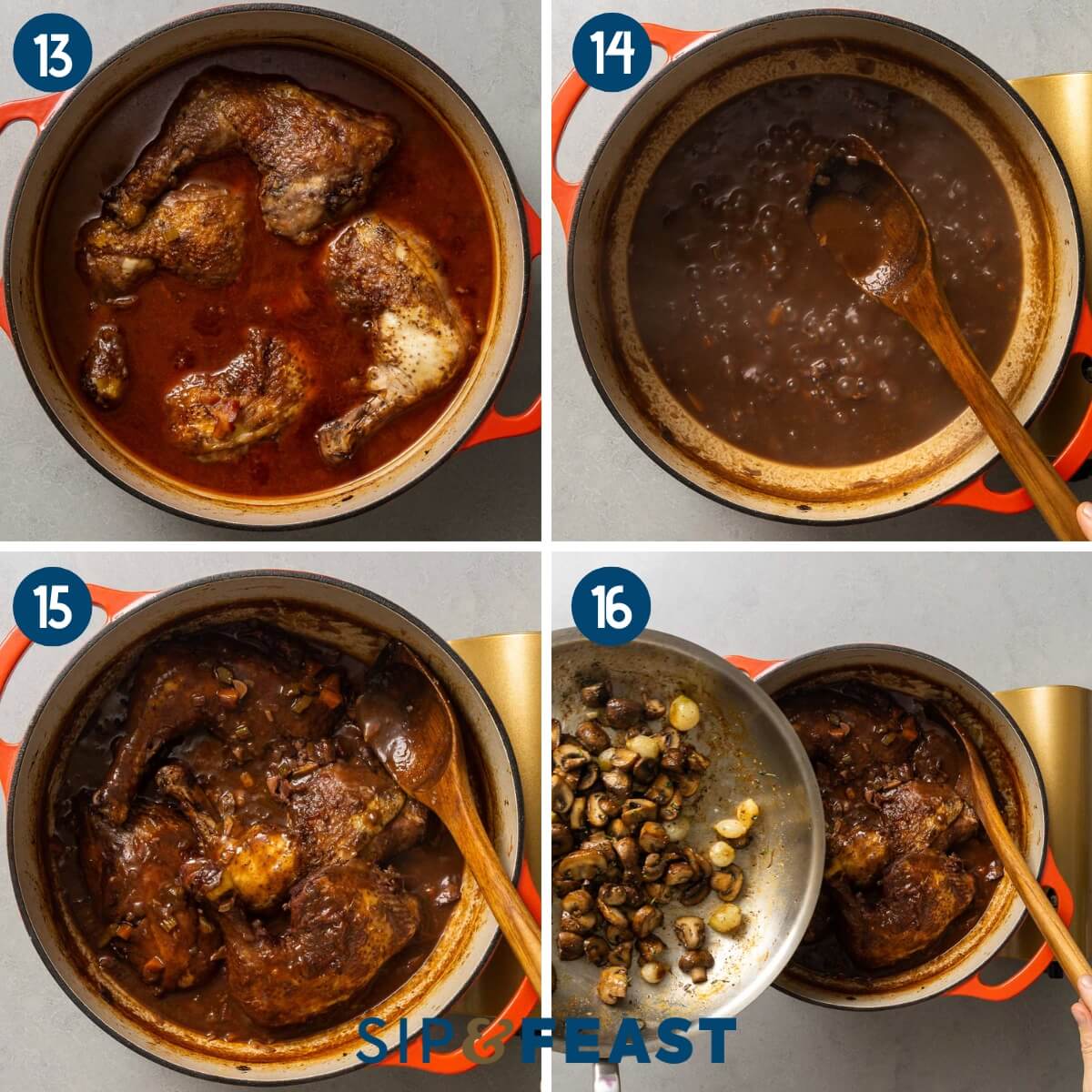
- Place the chicken pieces back in the pot and mix to coat (Photo #15).
- Add the parsley and either add the mushrooms and pearl onions to the pot, or divide them equally upon serving to ensure each person gets a similar amount (Photo #16). Serve the Coq au Vin with mashed potatoes or crusty bread and enjoy!
Top tips
- Make ahead. Like most soups and stews, Coq au Vin will taste better the next day, making it the perfect meal to serve for dinner guests! Simply store in the fridge overnight, then reheat by gently simmering on the stovetop at medium-low heat until hot. If you find the sauce is too thick, add some water to loosen it up.
- Use homemade stock. Using homemade chicken stock or homemade beef stock is a great way to elevate the flavor in any recipe calling for it. It also gives you greater control over sodium levels in your food since my homemade stock recipes call for zero salt.
- Chocolate. I’ve made Coq au Vin many times and find that adding a bit of dark chocolate (70% cacao or greater) adds complexity and greater depth of flavor. It is listed as an optional ingredient, but I highly recommend using it.
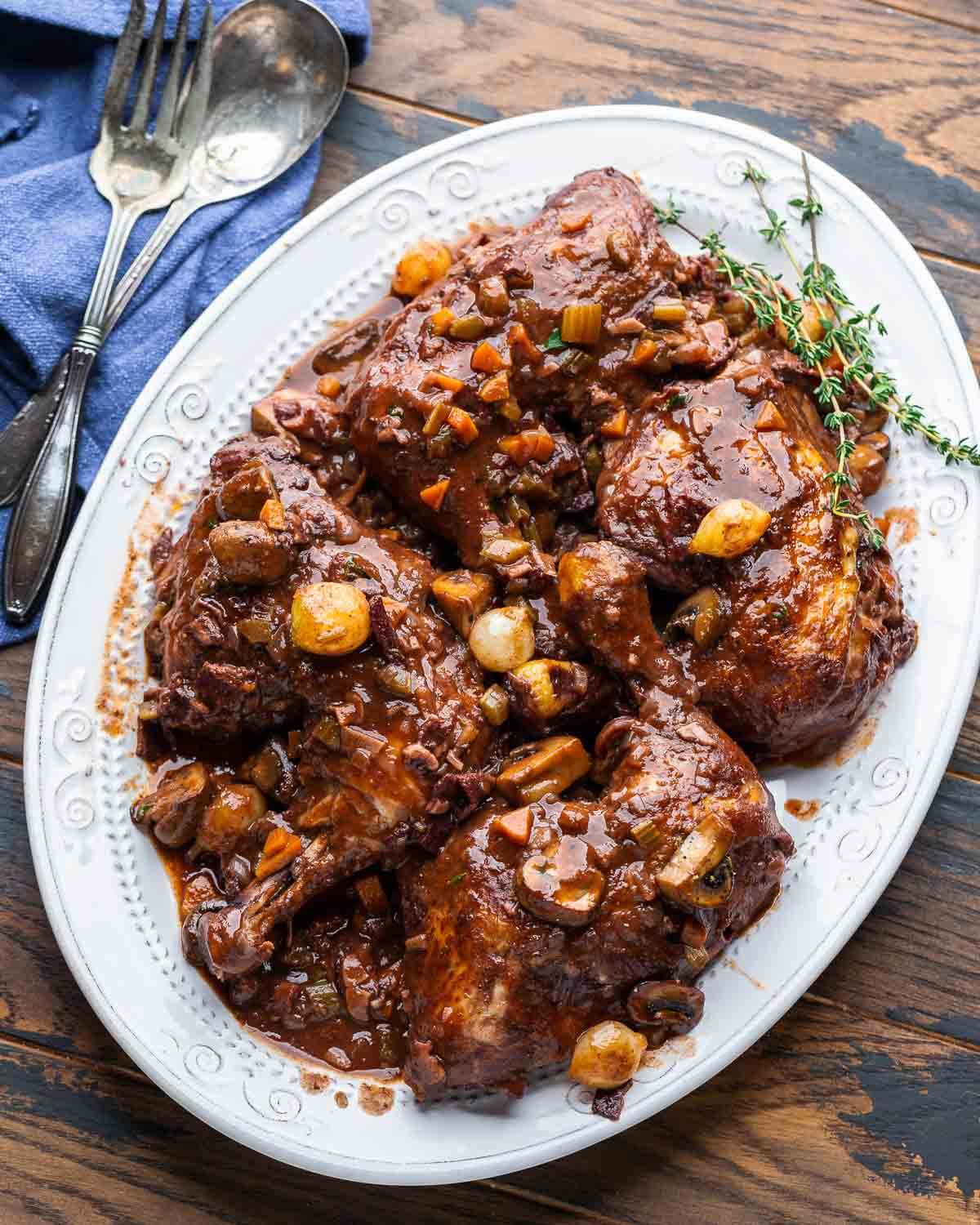
More comforting stew recipes
If you’re looking for more rich and hearty stew recipes, try these favorites!
If you’ve enjoyed this Coq au Vin recipe or any recipe on this site, give it a 5-star rating and tell us about it in the comments below.
We strive to satisfy a number of learning styles. If you are someone who prefers to learn by watching, you can find most of our recipes on YouTube and our Facebook Page.
Want To Save This Recipe?
Coq au Vin
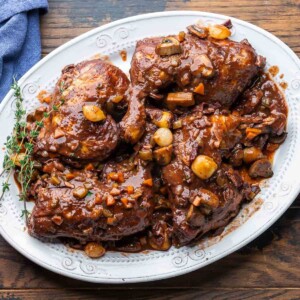
Ingredients
For the stew
- 4 ounces thick cut bacon cut into 1" pieces
- 3 1/2-4 pounds chicken thighs and legs
- 1 medium white onion diced
- 1 large carrot diced
- 2 ribs celery diced
- 5 cloves garlic minced
- 1/2 cup flour
- 3 tablespoons tomato paste
- 1 bottle Burgundy wine or other dry red wine
- 1 cup chicken stock see notes below
- 8 sprigs thyme tied together
- 2 large bay leaves
- salt and pepper to taste
- 1/2 ounce dark chocolate optional
For finishing
- 3 tablespoons butter
- 2 tablespoons olive oil divided
- 16 pearl onions
- 1 pound cremini mushrooms quartered
- 3 tablespoons flat leaf parsley minced
- 2 teaspoons fresh thyme leaves
- salt and pepper to taste
Want To Save This Recipe?
Instructions
- Trim the chicken thighs of excess fat. Place the chicken thighs and legs in a large bowl and pour in the whole bottle of burgundy. Marinate the chicken for at least 2 hours, but if possible overnight.
- Preheat oven to 350f and set the rack in the middle level, allowing enough room to accommodate a large Dutch oven with a lid.
- Heat a large Dutch oven to medium heat and add the bacon. Cook the bacon until most of the fat has rendered (7-10 minutes) then remove the bacon with a slotted spoon to a paper towel-lined plate to drain.
- Meanwhile, remove the chicken from the bowl and place onto a work surface, making sure to save all of the wine. Pat both the legs and thighs very dry and season with salt and pepper on all sides. Dredge the chicken pieces in flour and shake off all of the excess. Sear the chicken pieces in the bacon and chicken fat until well browned on all sides, working in batches if necessary. Place all of the chicken onto another plate and set aside.
- Remove excess bacon and chicken fat from the pot, leaving approximately a quarter cup in the pot. Add the onions, carrot, and celery to the pot and cook for 10-12 minutes or until they begin to soften then add the garlic and cook for another 2 minutes or until very fragrant.
- Add the tomato paste and cook for another 3-4 minutes, stirring frequently to avoid burning. If it starts to burn just add a couple of ounces of water into the pot to lower the temperature.
- Add the wine and chicken stock to the pot and bring to a boil for 2 minutes. Using a flat wooden spoon, scrape the bottom of the pot to remove all of the brown bits.
- Turn off the heat and add the chicken, bacon, thyme, and bay leaves to the pot. Cover the pot and place it in the oven to cook for 75-90 minutes or until the chicken is very tender.
For finishing
- Once the chicken is tender remove the chicken to a plate and cover with foil to keep warm. At this time, discard the bay leaves and thyme from the sauce.
- Skim any visible fat from the top of the sauce pot then place the pot onto a burner and turn the heat to medium-high. Reduce the sauce until thickened by about half (about 10 minutes). The sauce should be quite thick and will coat the back of a wooden spoon. Once reduced, taste test, and season with salt and pepper. Add the chocolate and mix until smooth. Place the chicken into the pot and mix well to coat. Cover with the lid and set aside.
- Heat a large pan to a touch higher than medium heat. Add the olive oil along with the pearl onions. Cook the onions until tender (about 3-5 minutes) then remove with a slotted spoon into a plate that is covered with foil.
- Add the mushrooms to the same pan and cook until they release their water and start to brown (about 5-8 minutes). Once they begin to brown add the butter and cook until they are glistening (about 2-3 minutes). Return the pearl onions back to the pan and toss/mix to coat. Turn off the heat and season with salt and pepper and the thyme leaves.
- Mix the parsley into the pot. You can mix all the mushrooms and pearl onions into the pot right before serving or divide them onto plates so that each person gets a few pearl onions and mushrooms. Serve with mashed potatoes or crusty bread. See notes below about serving the next day which is preferred.
Notes
- If possible, it’s best to let the pot cool and then refrigerate overnight. The flavors will be much more concentrated and the taste will be that much better. To reheat the next day, simply simmer on the stovetop at medium to medium-low heat until hot. If the sauce is too thick, just add a bit of water to loosen it up.
- Chicken thighs are best cooked until at least 185-190f so that the collagen and connective tissue begin to break down which makes much more tender and juicy bites.
- Makes 6 large or 8 moderate-sized servings.
- Homemade chicken stock is best, since there is no salt, which allows the sauce to be reduced until very thick without being overly salty. If you use homemade stock this recipe will work as shown. If using storebought stock make sure to taste test while reducing. If the sauce begins to get too salty, stop reducing it, and simply add a slurry of cornstarch (1-2 tablespoons mixed with 3 tablespoons water) and simmer until thickened.
- Leftovers can be saved for up to 3 days in the fridge and can be frozen for up to 6 months.
Nutrition
Nutrition information is automatically calculated, so should only be used as an approximation.
Follow Me







I think this recipe is perfect. So so good. I highly recommend this.
So happy you enjoyed!
Hi,
Love all your recipes. Will be making this one for my friends soon. I especially love the fact that the entire dish can be made the night before. Quick question: can I use frozen pearl onions?
Hi Anne, yes, you can 100% use frozen pearl onions. Hope you enjoy this one!
Thank you, Chef James.
I. made this for Christmas dinner and it was everything I expected! I’ll be making this many more times in the years to come!
Adam
So happy you enjoyed, Adam!
Delicious! It turned out so good! Thanks for the recipe and clear instructions.
So happy you enjoyed, Charles!
I’ve never made Coq au Vin before , but I used your recipe and…..ohhhhh myyyy! Just. So. Good.
I also made your Beef Bourgogne recipe a couple of months ago and it was an absolute winner too.
Thanks for doing what you do!
Hi Shaun, we’re so happy you loved this one and the beef bourguignon! Thank you so much for the great comment!
I see Julia Child instructs to cut bacon in lardons and simmer in 2quarts of water for 10 mins, rinse in cold water, pat dry. Sauté the bacon in hot butter until very lightly brown…. Ensuring less salt in the dish – “Mastering the art of French cooking”
My family isn’t fond of chicken on the bone or dark meat. Could I use chicken breasts(cutlets) for this recipe? How would I adjust the cooking time for that? Thanks love your recipes! Have a cooked a lot of them.
Hi Michele, this dish is really intended for tougher meat (which was why it was originally made with rooster). It’s meant to be braised for a while to break down the connective tissue and fat which breasts have very little of. During the braising process, the chicken flavors the sauce as it thickens. This is not a dish we’d recommend using breasts for as it would really alter the entire dish. We’re so happy you’re enjoying the recipes and appreciate the comment.
Delicious! The only thing I would change is, if you only have chicken with fatty skin (which I did) you may want to trim most or even all of it. Thank goodness for the Jacques Pepin tip you taught me to absorb fat off the final sauce. 😁
This was a huge hit in our house! Will definitely make this again. Highly recommend pairing with your roasted garlic mashed potatoes.
Hi Crystal, we’re glad you enjoyed the recipe and thanks for the comment!
We watched your video and two nights later I was following your recipe. My first time making this dish and it turned out fantastic! My husband and son enjoyed it very much and the dark chocolate absolutely helped bring the flavor up a notch. Can’t wait to try this as a leftover!
Hi Nikki, thanks for the comment and so happy you enjoyed the recipe!
What’s not to like about this recipe!! Watching your video, I literally wished that I could have “beamed in” (Star Trek reference) to be one of the “official tasters”. I can hardly wait to make it. Quick question: Since the recipe calls for dry red wine and tomato paste — and a pinch of sugar can often enhance the tomato flavor — and I plan to add the dark chocolate — do you recommend that the dark chocolate be unsweetened or sweetened — or would it not make any difference?
Hi Ellen, thanks for the comment! Jim doesn’t think any sugar is needed here. The sauce reduces quite a bit and the wine and tomato flavors certainly get sweeter while cooked. He used Ghiardelli 72% Intense Dark chocolate for this recipe if you want to use that as a reference. Hope you enjoy!
Hi, Tara. Thanks for letting me know that I don’t need to add any sugar to the sauce. I’ll use the Ghiardelli 72% Intense Dark chocolate so that I recreate the exact recipe. (I’m always a little intimidated by French recipes.) Over the coming Holiday Season, I plan to serve this Coq au Vin dish using Jim’s recipe for Roasted Garlic Mashed Yukon Gold Potatoes, or — if that seems like too much garlic for my guests since the Coq au Vin requires 5 cloves of garlic (which I personally love) — then alternatively, I will make the mashed potatoes using the same recipe, but instead of the roasted garlic, I’ll fold in cream cheese with chives while the potatoes are still warm. .Either way, this Coq au Vin dish is filled with a combination of ingredients prepared in a way which enhances their various flavours that work extremely well together — including the chocolate. I look forward to making and serving it very soon. Thanks again!!
This recipe sounds delicious! Can I use turkey bacon?
Hi Alicia, the bacon in this recipe is the main source of fat to start the dish. Turkey bacon tends to be very lean so if you do use it, you should supplement the fat by adding oil. Hope you enjoy!
The recipe looks great, it’s a definite make in my house. Question is, what do you recommend to serve with it.
Hi Marty, in this first section of the post Jim mentions this is great served with crusty bread, mashed potatoes, or creamy polenta. Hope you enjoy!